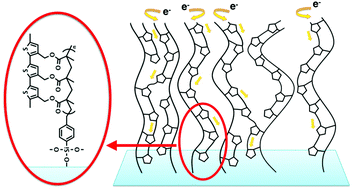Conductive polythiophene-based brushes grafted from an ITO surface via a self-templating approach†
Abstract
Conductive polythiophene-based brushes grafted from an indium tin oxide substrate were fabricated as promising materials with directional conductivity for potential optoelectronic applications. The obtained brushes, thanks to their ordered structure and large conjugation length, exhibited high conductivity after chemical doping. Surface-initiated photoiniferter mediated polymerization of a 3-methylthienyl methacrylate monomer was used in the first step of grafting enabling formation of dense brushes. In the second step a self-templating approach that utilized oxidative polymerization of the pendant thiophene groups in the grafted multimonomer chains was used for the formation of ladder-like conjugated brushes. The polymerization conditions were optimized towards the largest possible effective conjugation lengths of the macromolecules. The rate of the undesirable spontaneous iodine dedoping process was followed for the first time using conductive atomic force microscopy. UV-VIS and grazing angle IR spectroscopy were applied to find correlations between various synthetic procedures and the conjugation lengths of the brushes.


 Please wait while we load your content...
Please wait while we load your content...